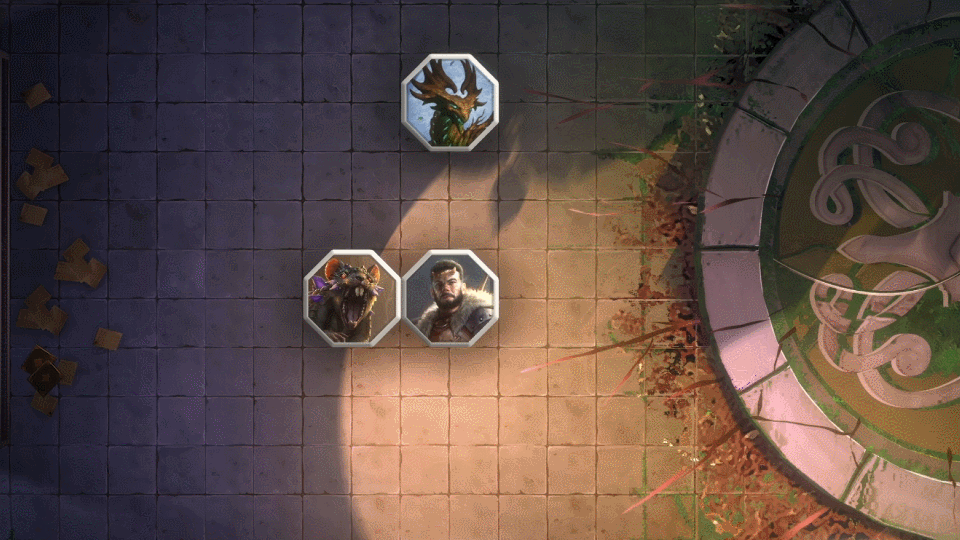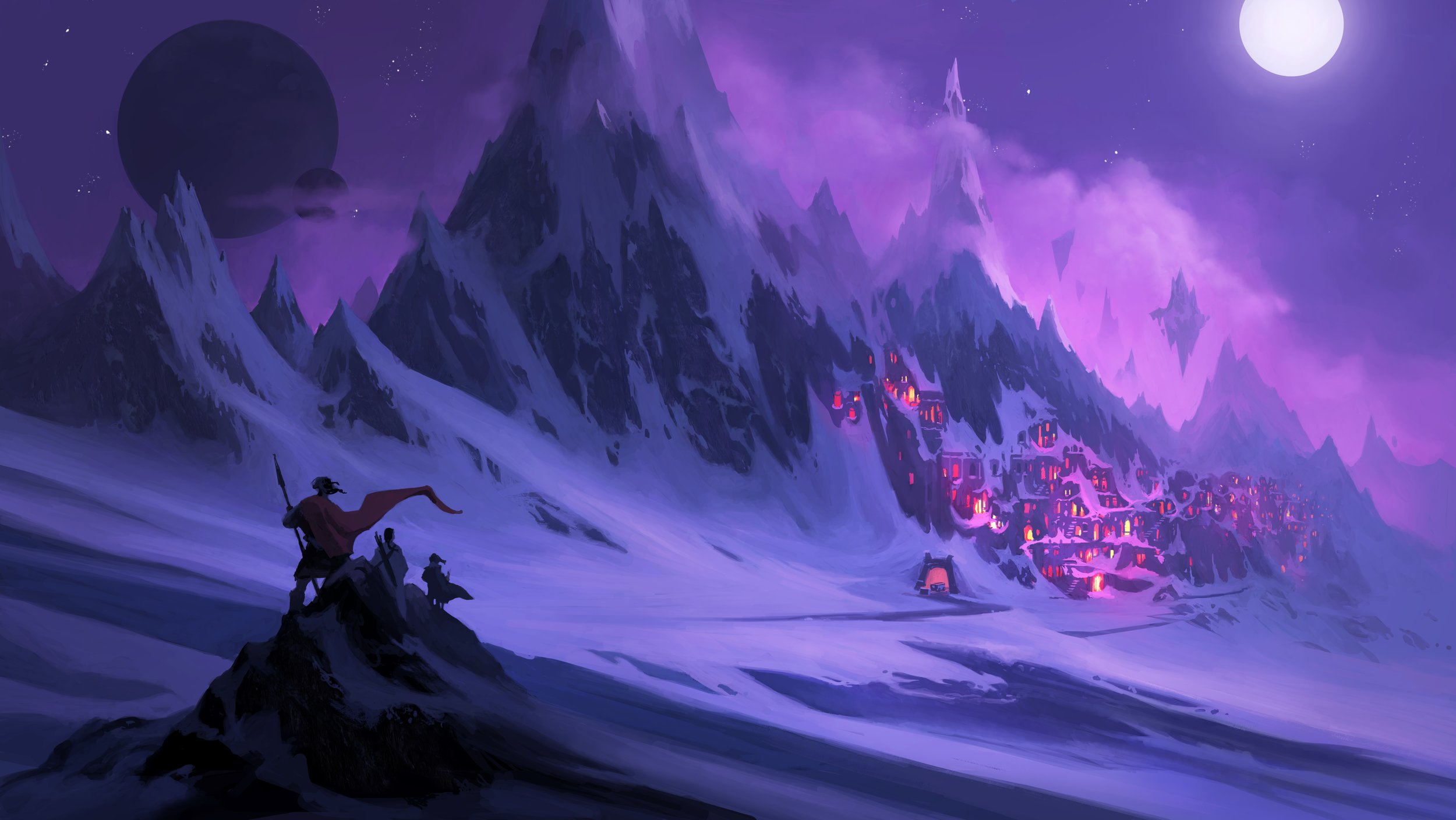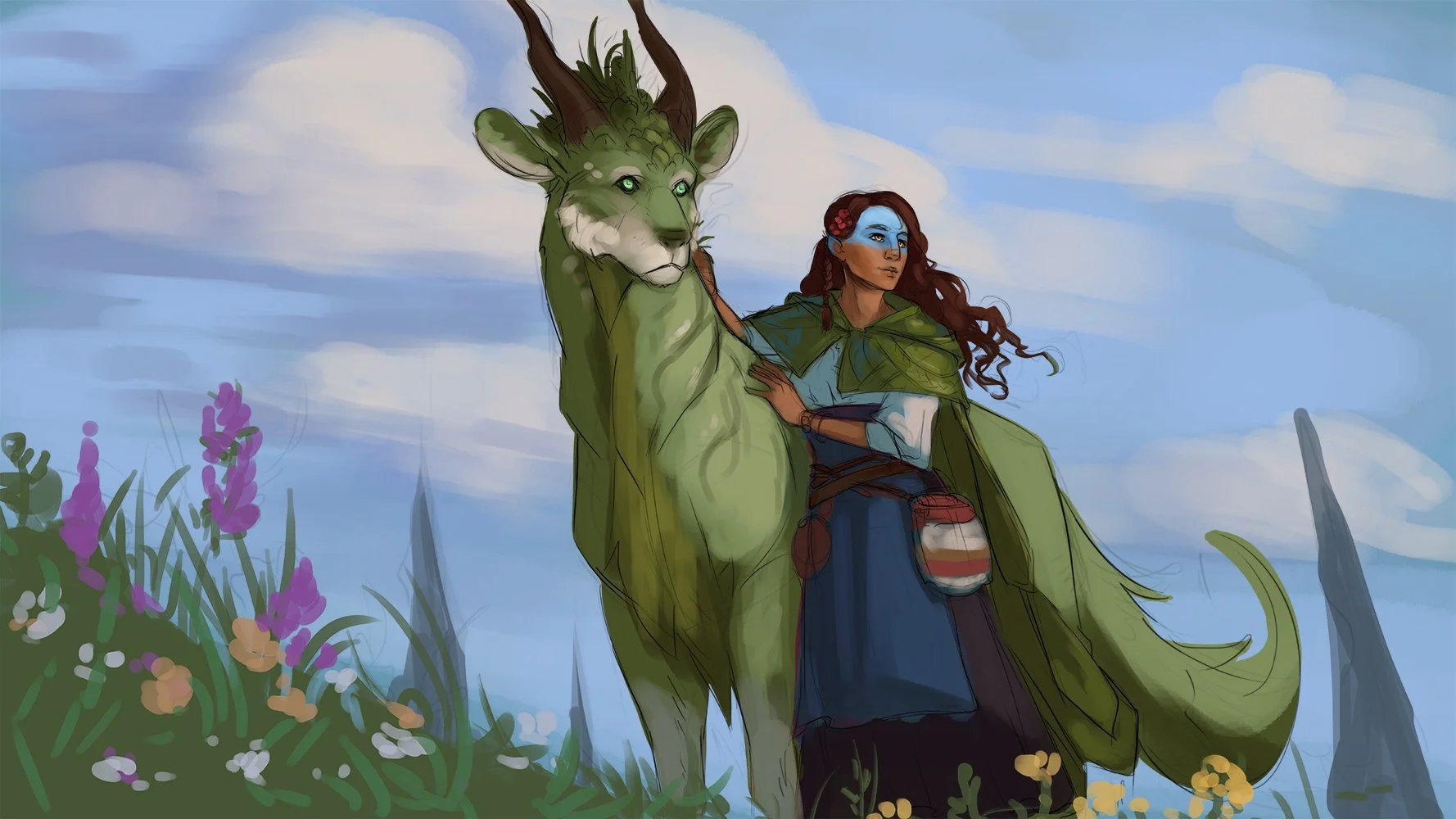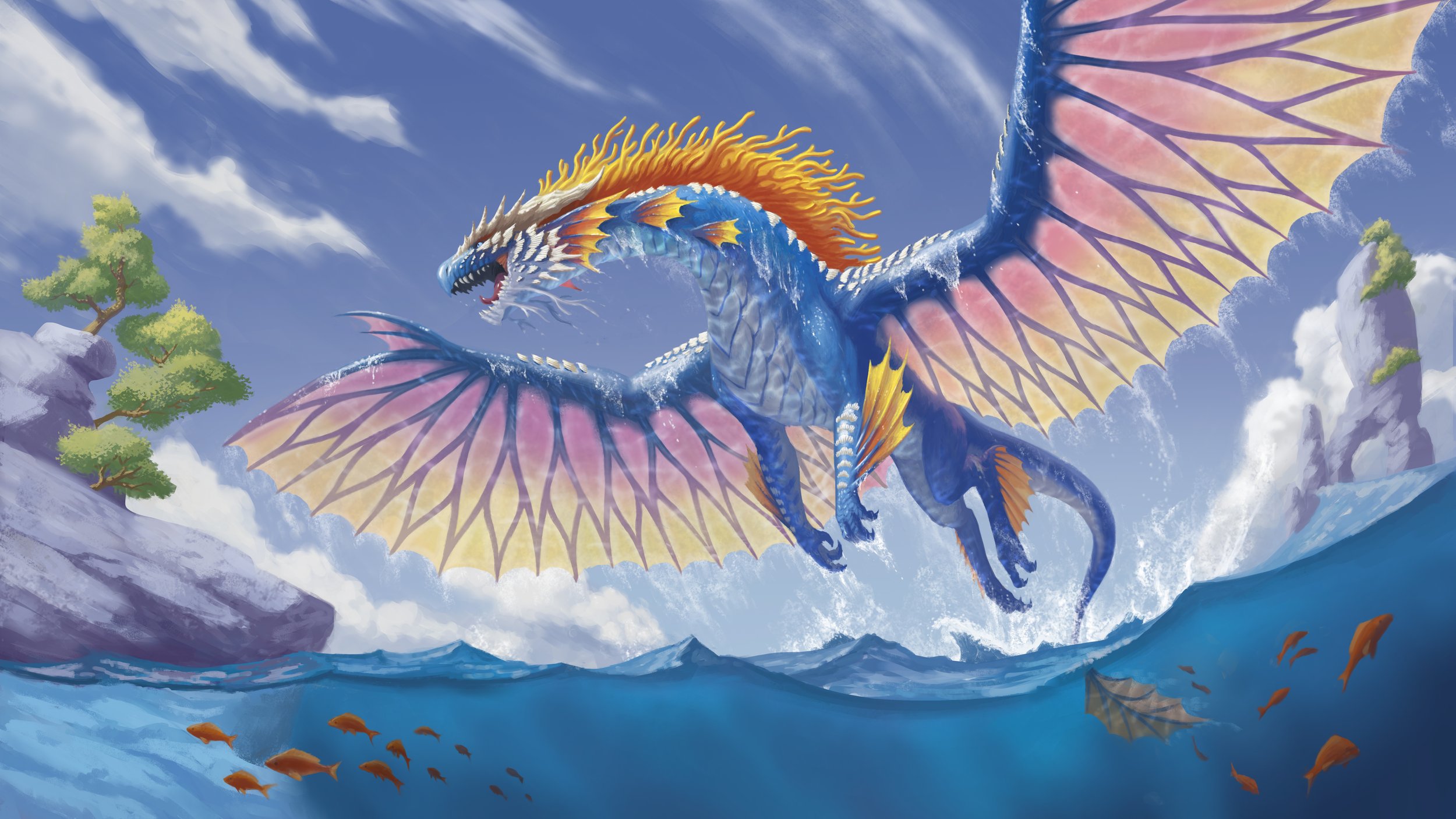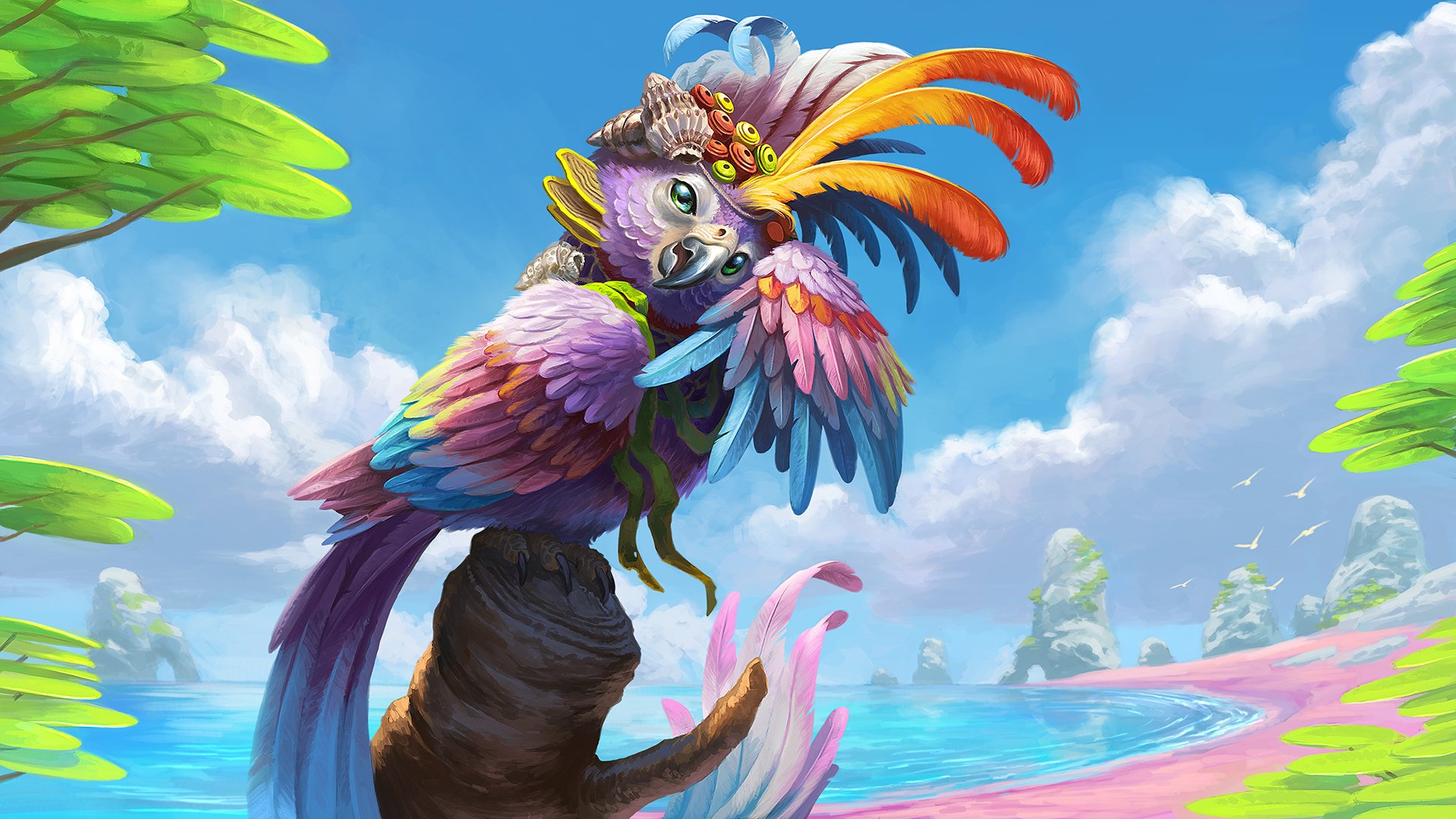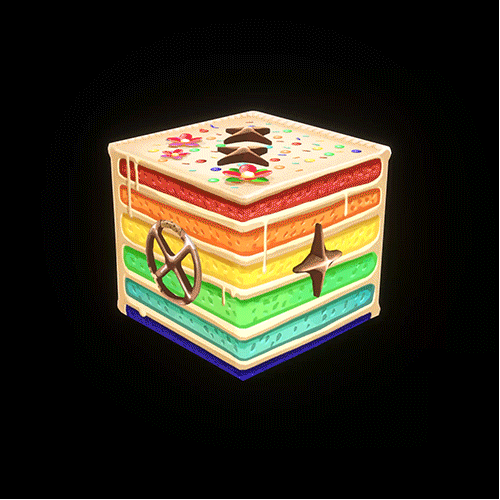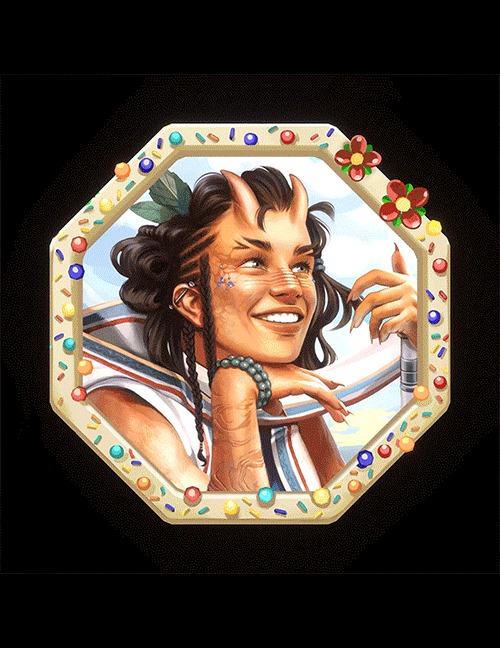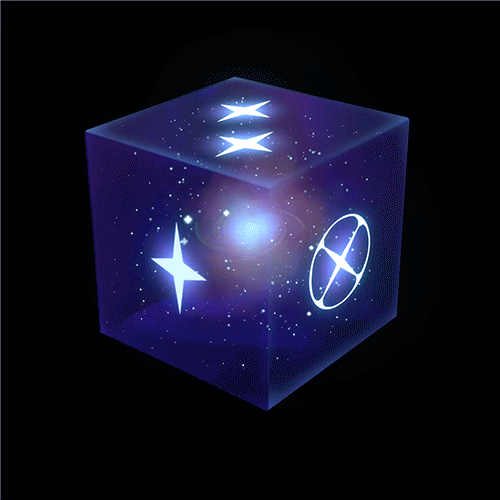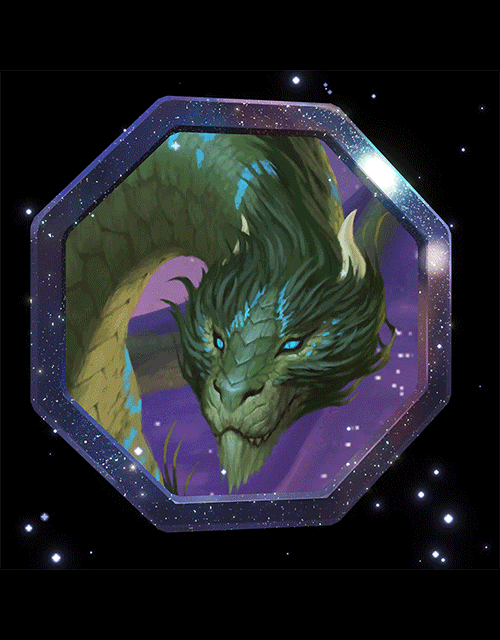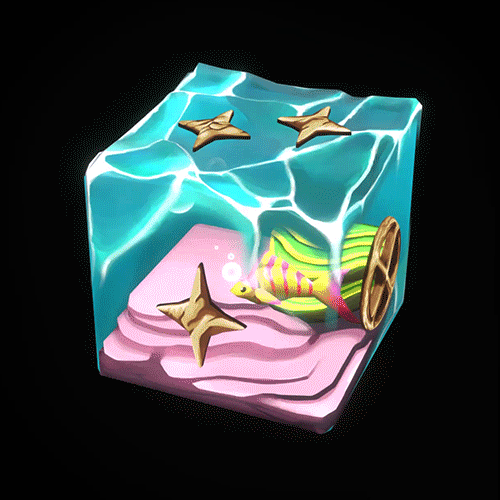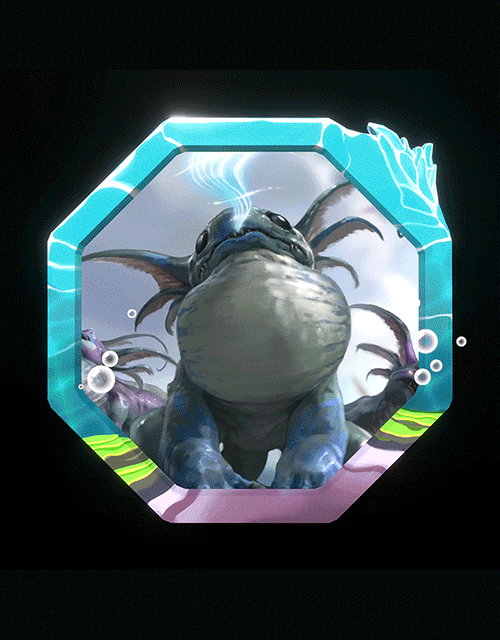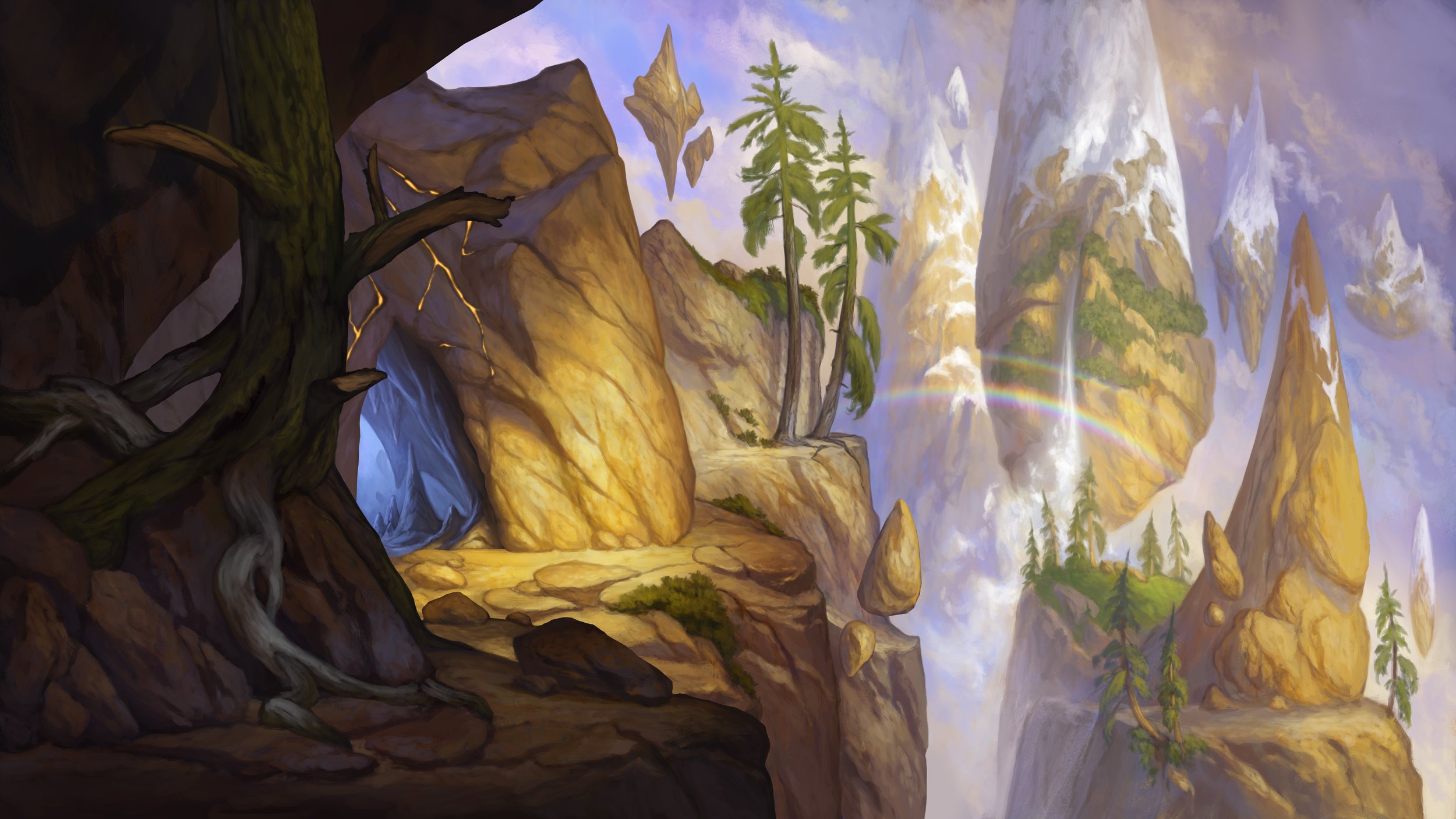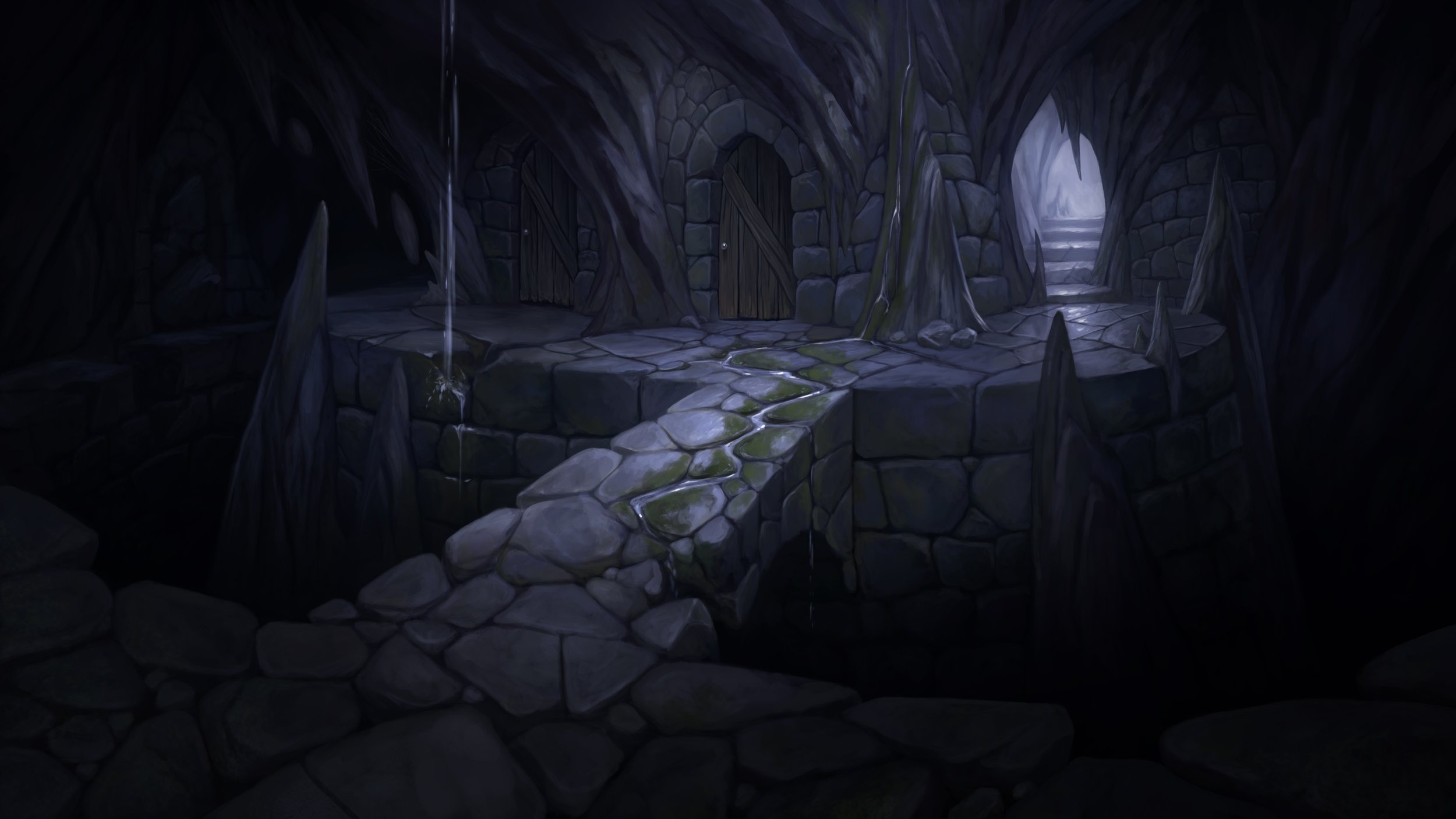Sam Burley on finding inspiration, working with great mentors, and keeping up with change
Sam Burley on the path towards fantasy illustration, advice for aspiring artists, and more!
From vibrant Coastal scenes (and the creatures who inhabit them), to the most famous ship in Mythas (The Tipsy Pearl herself!), Sam Burley is a master of shape, color, and composition. Pink sands and puffy clouds? Sam’s got it down. Oozey blobfish monsters that are still kinda cute? Sam’s got that covered too. He’s really made a… ahem… splash with his stellar designs! In fact, we’d go so far as to dub him the o”fish”al Coral Coast King! Players will have the opportunity to take a closer look at Sam’s work in Fablecraft’s upcoming adventure, The Murder on the Tipsy Pearl.
Name: Sam Burley
Socials: @SamBurleyArt | @samburleyart | samburley.com
Can you tell us a bit about how you became a professional artist?
SAM: I was always into art projects as a kid and was lucky enough to have a supportive family alongside a high school with spectacular art programs. That got me into an art college where I meandered a bit until some really great mentors helped me see the path towards fantasy illustration and subsequently guided me toward it.
A ship sails across the Mythan Sea.
After school I had a couple of odd jobs with matte painting, 3D texturing, and concept art… but my fantasy portfolio wasn’t quite where it needed to be yet, so I was doing a lot of personal projects on the side geared towards that. Eventually I was able to get some illustration work with small clients, which gradually grew into more and larger clients from there.
The Coral Coastline and a stilted town in the distance.
The Captain’s quarters aboard the Tipsy Pearl.
Today I happily split my time between various illustration and concept art jobs, mostly within the sphere of table-top gaming. And also I’m not good at most other things so it’s really really nice that career path worked out!
A Malevolent Ooze. These shapeless blobs form when cruel wishes are made at a wishing well.
Who are your biggest artistic influences?
SAM: Lars Grant West is one of those mentors I mentioned earlier and he is an exceptionally kind soul in addition to being a world class fantasy artist. He’s somebody I admire greatly, and it’s impossible to overstate the profound impact he’s had on my art and career. There’s also the Hudson River School artists like Albert Bierstadt and Thomas Cole which are some classic landscape favorites of mine. Finally I’d say Gary Tonge and Raymond Swanland are two contemporaries that I always find myself coming back to. In both cases I love their sense of shape, color, and dynamic compositions.
A vibrant and bustling Coastal marketplace.
Tell us about your favorite medium.
SAM: I’m a Photoshop guy. I was brought up on traditional mediums, but made a full switch during art school. I occasionally mess around with other tools, but nothing else ever quite sticks for me.
A Sandlander concept piece.
A hypnotizing chorus of Sandlanders evoke pleasant memories, luring targets into a trancelike state.
What are your main sources of inspiration?
SAM: Oh gosh, everything. Nature, clouds, animals, national parks, the cosmos, mythology, games, books, television, and of course other artists. I’m constantly taking pictures of random leaves and textures, and screenshotting various media, most of which I’ll never even look at again.
Coastal towns are alive with art and music. The local tavern crowds are renowned for breaking out into sea shanties at regular intervals, and once one person starts to sing, the other patrons find it hard to resist joining in.
It could be as simple as the color palette of a movie frame, or the wildly deep and complex job system of whatever RPG I’m playing. Sometimes a blessing, sometimes a curse; there’s always a dozen half-formed ideas bouncing around my skull, but pinning any one of them down long enough to actually act upon is the challenge.
Below decks aboard the infamous Tipsy pearl.
What is your favorite piece of Fablecraft work that you didn't work on? We would love it if you would shout out another artist whose work you admire!
SAM: Robson Michel’s Bone Collector. Really cool design, and it’s especially challenging to make things creepy AND cool, but not totally gross. I just love the anatomy which feels equally mysterious and plausible.
Robson Michel’s Bone Collector, proudly displaying the bones of its victims.
How would you personally define success as an artist?
SAM: The easy answer is enough fame to keep clients coming in the door, and enough fortune to keep the bills paid. But for me the truer and more elusive goals is simply making art that I’m proud to have my name on and, more importantly, to keep my anxiety in check. I think many artists struggle with stress, imposter syndrome, and a compulsion to constantly be improving.
Decorator Crabs bedazzle their shells with found items. They seek what others most desire, whether trash or treasure, and are open to trade if the price is right.
As a result we (certainly I) love beating ourselves up and can forget to zoom out and enjoy the 20,000 foot view sometimes. It’s so easy to fall into a static rhythm of day-to-day, deadline-to-deadline, and “Sure, I can squeeze in one more assignment...”. Lately I’ve been making an effort to schedule time off and ask myself “Should I take this assignment,” instead of “Can I take this?” The distinction is not always an option unfortunately, but that’s the goal at least.
A ship approaches on the Coastal horizon… but something appears to be lurking in the water!
Any advice for aspiring artists out there?
SAM: My biggest recommendation for getting into the industry is to target specific clients you want to work for. If you want to be an illustrator for a specific brand, then have several pieces in your portfolio that match the quality, style, and subject matter of that brand. Eliminating any risks and leaps of faith on the art director’s part is what will make you appealing as illustrator.
A deserted island during the day.
A deserted island after night has fallen.
And I can’t help but acknowledge the elephant in the room, AI. There’s a lot of noise right now, but I don’t think anyone can say for certain where some of the very real legal and moral issues will land, or how image generators will fit into the future bottom-lines of any industries you’re hoping to get into.
A beautifully adorned room aboard the Tipsy Pearl.
My own advice though would be to stay relevant by playing around with it yourself. You don’t have to be a master or even an advocate. But it’s prudent to have some grasp of how it works, what the AI’s strengths and weaknesses are, and be able to identify when it’s being used by others. A warning too though: don’t become dependent on it, and avoid inputs that will easily lead to plagiarism (even accidentally). The best and safest option IMO is to treat the AI images as though another human created them… don’t take credit for having created them yourself and restrict your usage to visual inspiration only rather than integrating images into your own work directly.
A vicious Tidemaw emerges from the water.
Finally, make sure your portfolio is easily accessible online, and try to limit it to your best work. Social media is progressing rapidly enough that I don’t have the firmest grasp on the best options out there these days… but I know plenty of art directors still surf Art Station for new talent. Instagram comes to mind too. If you ever have the opportunity to show your portfolio to a possible client in person (like at a convention), even better, and even if you don’t feel ready yet!
The colorful deck of the one and only Tipsy Pearl.
Check out more of Sam’s work on Riftweaver’s new TTRPG, Fablecraft. Fablecraft is a cooperative digital tabletop roleplaying game set in the vibrant, hopeful world of Mythas. The platform integrates interactive battlemaps, video, audio, and text chat, digital dice and unique game system, and a library of artwork and music, to bring your stories to life.
Robin Wouters reflects on his VFX odyssey, finding inspiration in nature, and the perks of work-life balance.
Robin Wouters on the road to working in VFX, finding inspiration in nature, and the perks of work-life balance.
No animation or effect is too big or small for the incredible Robin Wouters! From conjuring flames and ice to intricately weaving magical branches and breathing life into clockwork monsters, Robin's creative genius knows no bounds. Dive into the fascinating world of game VFX blended with a touch of dramatic flair, not to mention some of our favorite animations!
Name: Robin Wouters
Pronouns: He/Him
Location: The Netherlands
Artistic superpower: Brainstorming VFX in sound effects
Interests beyond VFX: Video games, spending time in nature, cooking
Couldn't live without: My wife and daughter
Favorite ice cream flavor: Cookie dough
Socials: @RobinVFXlabs | @robinwouters | @robinvfxlabs
Can you tell us a bit about how you became a professional VFX artist?
It's been a bit of a journey before I ended up doing VFX. I've always been very passionate about video games, they've been a part of my life for as long as I can remember. My first game was Pong on our Atari 2600. Later we got a PC and I spent so much time playing DOS games. I also loved animation, watching cartoons and the limited amount of anime that was shown on TV (Pokemon and Dragonball Z). My childhood dream was to be an animator. I always liked the animated Red Bull commercials, and for some reason I thought that was a more viable career choice than making games or cartoons.
Lightfall: rain down light that heals or harms those it touches.
I ended up going to a graphic design oriented high school and eventually studied multimedia design where I specialized in animation. My passion for games led me to a game art study at Utrecht School of the Arts. I really got into concept art and illustration during that time. I seized a few great opportunities like studying illustration at Kyoto Seika University in Japan and interning at Guerrilla Games as a concept artist, where I contributed to Killzone Shadow Fall and Horizon Zero Dawn.
Shadowy Thoughts: drain your healing power to supercharge your attack.
After graduating I freelanced for a while, just barely getting by due to the insane amount of competition. Eventually I figured that this wasn't it for me, and I started working as a game art generalist at a small mobile game developer. I was doing everything ranging from concept art, UI design, 3D modeling, animation, to of course VFX. During this time I discovered my passion for VFX and I ended up specializing in it. The company had a couple of hit games and saw rapid growth, going from 3 people to 30+ in a short amount of time. Eventually we started a big project where I was able to work as a dedicated VFX artist. After wrapping that up, we would return to generalist roles. I couldn't get behind that decision, so I left the company and started working as a freelance VFX artist.
Withering Orb: toss a ball of light laced with shadow magic.
Who are your biggest artistic influences?
There are way too many great VFX artists to name. I'm in a few VFX-related Discord servers where everyone helps each other improve and solve problems. I continue to learn a lot of technical and artistic know-how from my buddies there.
Healing Touch: heroically aid a friend in need.
What are your main sources of inspiration?
Obviously video games, but more specifically I love fantasy themed (A)RPG's, they tend to have the most amazing VFX. I'm currently over 100 hours in Baldur's Gate 3 and I just can't get over how amazing the VFX are. I also occasionally watch anime, which is another fantastic source of inspiration. Japanese animators are insanely good at impactful and over-the-top VFX. Besides that, real life is often the best source of inspiration. Nature is especially full of motion, raindrops splashing in puddles, leaves tumbling in the wind, smoke coming from chimneys. Whenever I see something interesting, I grab my phone and shoot some slow-mo footage. The other night while I was cooking some curry, I noticed nice bubbles forming and popping. Perfect reference for a bubbly swamp or a poison bomb.
Token Death, Shadow Variant: when all HP is lost.
Tell us about a day in your life as a VFX artist.
It wouldn't be much different from any other desk job, to be honest. The major difference is because I'm self-employed, I get a lot of freedom with how, when and where I do my work.
I typically get up early, between 6.00 AM and 6.30 AM and I do a bit of work right away (often still in my pajamas). Once my wife and daughter are up and preparing for the day, I join them for breakfast. Then I get dressed, freshen up, grab a coffee and head back to work.
Read The Room: drop some explosive reading material.
Later in the morning I go on my daily walk with my wife. Rain or shine, I need to go outside and get some fresh air. Besides the physical exercise, these walks work wonders when I'm stuck on something—I've managed to solve most, if not all, problems this way. Then back to work for a bit. Just before lunch, I take a moment for meditation. After lunch, I continue working until I feel satisfied with the amount of work done.
Spine Smash: rear up and crash down with full force.
Can you walk us through your process when working on a VFX for Fablecraft, from brief through to final execution?
I read through the brief and check out the artwork and references. I double check the gameplay descriptions and then start thinking about what the attack does from a game design standpoint, how it can be visually communicated to the player in a way that it's clear and meets the player's expectation. Note that brainstorming comes with a plethora of sound effects and hand gestures. Ideas usually immediately come to me, but sometimes it requires some sketching. So in that case I just do some scribbles until I get a good idea of what to create.
Lore Drop: rain down books and form a deadly stack.
Then I start building the effect, usually starting with a rough blockout to get the general motion and timing right. Then I start building the visuals, creating 3D models, textures etc. When I just joined the project, I built a master shader that supports 99% of everything I need for VFX. But sometimes I need something really specific, for example the growing vines in Rousing Howl, so I build a new shader for that specific functionality. As the effect takes shape, there's a point where I can just hear the sound effects in my mind. This usually signifies that it's headed in the right direction and becoming a satisfying effect. When I'm happy with it, I send it over to David for notes. His response is often with a ton of enthusiasm and praise, and sometimes a few notes. Then it's a matter of tweaking and fine-tuning things based on his feedback, and then sending it back for a final check and approval.
Pendulum Swing: tick, tock, bring your foes to a stop.
Talk us through one of your favorite Fablecraft VFX pieces. Which element(s) are you happiest with? What was the most challenging part of working on this piece?
Melt Armor is one of my favorites. For starters I love doing stylized fire effects, it's a powerful element and challenging to get right. The idea of displaying the token's silhouette came fairly late in the process. I was inspired by a character getting shocked, you see the skeleton light up through the silhouette, like old school cartoons. It gave me the idea of showing the scorched silhouette of the token through the flames. I did a quick test and it turned out great.
Melt Armor: make your enemy’s armor too hot to handle.
What is your favorite piece of Fablecraft work that you didn't work on? We would love it if you would shout out another artist whose work you admire!
Ooh it's hard to pick one, Tian and Diego both did amazing work. I have to say I love the Gravimancer's effects. Beautiful use of color, and the space theme is great. And of course all the beautiful illustration work, the characters, creatures, environments, it's all gold.
Gravimancer Hit Effects: well-suited to running headfirst into danger, they’re the tanks of combat, using gravitational force to leap, smash, and hinder enemy movement.
How do you manage a work-life balance as an artist?
I'll let you know as soon as I figure it out!
Jokes aside, it's been a real challenge. I'm lucky enough to have my own office space at home, but it does mean I'm at home 24/7 and work-life just kind of blends together. Another factor is the time difference, so I'm often still chatting with David late in the evening. But being self-employed definitely has its perks, it allows me to be very flexible in terms of work times. So if I get stuck or feel like I'm not as productive, I just take a break, do something away from my PC, I can always pick up work later. But the best perk of all is being able to see my daughter grow up, not many fathers share that privilege.
Rousing Howl: the strength of the wolf lies in the pack.
How would you personally define success as an artist?
Simply being able to earn a living wage. I feel very privileged to be able to do what I love while providing for my family.
Icicle Volley: rain shards of ice from above.
What are your ultimate career goals?
I would absolutely love to work on any of my favorite franchises. I love Diablo, Monster Hunter, or any Nintendo franchise like Zelda or Metroid. I even had a dream recently that I was hired to work on a Kirby game.
Besides that, I started working under the VFXlabs name with the flexibility to someday scale up, hire people and turn it into a studio. It's not an ultimate career goal per se, but it might be cool being able to take on bigger projects with a team.
Time Bomb: start the countdown to detonation.
Any advice for aspiring artists out there?
You’ll need a very broad skill set for VFX, like visual design, animation principles, 3D modeling, texture creation, technical knowledge like shader creation etc. Even if your goal is to work in VFX, taking on a generalist role first can be really beneficial. It's a fantastic way of entering the game industry and getting a solid foundation for VFX. I've learned a ton during my 10+ years as a game developer, and I still apply a lot of this knowledge to VFX.
Hammertail Surge: a swing and a hit.
What advice would you give to your younger self?
It's alright to change course if something is not working out. I tried forcing myself into a concept artist/illustrator career which just wasn't for me. Stepping back from this was the best thing I did at that time. And also: don't forget to have fun.
Stellar Luck: your target's fate is written in the stars.
Are there any upcoming projects that you are excited for?
I don't have any new projects planned. I've been working with Riftweaver for over 7 months now and I'm still having a great time working on Fablecraft!
Aleksandra Wojtas on the winding path toward becoming a full time artist and working on dream projects
Aleksandra Wojtas on the winding path toward full time artist and working on dream projects.
How we love Aleks, let us count the ways. One: her wild, but methodical imagination. Aleks was critical in helping us design the sky-mirrored brows and cat eyes of our Longstriders, and the unique fish patterns and hairstyles found on our Wavechasers. Two: her attention to detail. The fabrication and practicality of woven grass cloaks or netted coastal fabric was all Aleks! Three: Personality. Aleks creates little stories with each character she draws and they are all brimming with life. Below you’ll meet just a few of the characters Aleks has designed!
Name: Aleksandra Wojtas
Socials: @venrin.bsky.social | @Venrinn | @ven.rinn
Location: Poland
Artistic superpower: Unstoppable curiosity
Interests beyond illustration: Games, photography, fantasy books
Couldn't live without: Earl grey tea
Favorite ice cream flavor: Vanilla
Can you tell us a bit about how you came to be a professional artist?
ALEKS: I was always interested in art and drawing since I was little! For a long time I was sure I was going to be a childrens’ book illustrator. I had, however, some rather unsupportive adults in my life which led me down the path to completing a masters in finance of all things. I was very unhappy on this path and decided to try pursuing art one last time. I applied and got into FZD School of Design in Singapore, after which I was very lucky to find a job at CD Projekt Red as a 2D artist first, then illustrator.
A Wavechaser who takes things one wave at a time.
Tell us about your favorite medium?
ALEKS: 95% of work I do right now is done in Photoshop - I’ve used it for so long it feels like second nature. However on the rare occasion I use traditional media. I love oil and gouache.
A Longstrider and her feathered companion.
Can you walk us through your process when working on Fablecraft artwork, from brief through to final execution?
ALEKS: After receiving a brief from Darci (our amazing AD) I would first dive into researching and gathering my thoughts. If we were starting all the way down from concept work we would spend some time talking through references, inspirations and initial sketches to determine the direction the character or race should take. I would then focus on creating black and white thumbnails for the illustration - trying to capture the story and personality of the character, and establish the composition. Once we were both happy I would move forward with color and rendering of the piece, noodling on it until I am happy!
Wavechaser concept art
A fearless and bold Wavechaser who courts chaos wherever she goes.
Talk us through one of your Fablecraft pieces. Which element(s) are you happiest with? What was the most challenging part of working on this piece?
ALEKS: I think the most interesting illustration to talk about is that of Maz the Bartender. It started from an extremely rough sketch that had an idea I loved: a round bar surrounding a large tree. I fleshed out the sketch and pretty much run to Darci for approval of the idea :D Painting Maz was pure pleasure, as was the magical drink being served. The most challenging part was balancing out the values but I think I managed in the end!
Maz early concept sketch
No matter where you find yourself in Mythas, the sight of Maz is always a welcome one.
How would you personally define success as an artist?
ALEKS: Truth be told, I am constantly evaluating what success means to me. Working on dream projects (like Fablecraft!) is how I would define success as an artist for myself. When I hear someone enjoyed the work I thoroughly enjoyed creating I feel the happiest.
You never know what kind of sidekick a Wavechaser might pick up during their travels.
Longstrider concept art
Nomadic Longstriders can be found adventuring throughout the Long Meadows.
Any advice for aspiring artists out there?
ALEKS: Don’t be afraid to experiment! Not every single work needs to be a finished painting, and not every work will be better than the last - that’s totally normal. Cultivate the mindset of growth and enjoy the process, it’s the best way in my opinion to create unique art and reach your full potential.
A Wavechaser performer with an enchanted voice.
Check out more of Aleks’s work on Riftweaver’s new TTRPG, Fablecraft. Fablecraft is a cooperative digital tabletop roleplaying game set in the vibrant, hopeful world of Mythas. The platform integrates interactive battlemaps, video, audio, and text chat, digital dice and unique game system, and a library of artwork and music, to bring your stories to life.
Andreas Rocha on maintaining balance, zooming out, and the quest for the perfect painting
A labyrinthine wildwood, a grove of cursed oaks, floating mountains in an evening snowstorm, or an enchanted, dilapidated manor house... these are just a handful of the environments that Andreas has created over the last year for Fablecraft.
A labyrinthine wildwood, a grove of cursed oaks, floating mountains in an evening snowstorm, or an enchanted, dilapidated manor house... these are just a handful of the environments that Andreas has created over the last year for Fablecraft. As one of our primary environmental artists, Andreas is a wizard at conjuring new and strange landscapes and interiors. You can see his pictures throughout the regions of Mythas, but none more extensively than the Wildwoods. He is also the driving force behind the strange and wonderful rooms players will explore in the upcoming Fablecraft adventure, The House in the Manor.
Name: Andreas Rocha
Socials: @andreas.rocha | @andreas_rocha
Location: Lisbon, Portugal
Artistic superpower: Being aware of my flaws!
Interests beyond painting: Board games, eating (and cooking), jogging, walking around nature, and Lisbon
Couldn't live without: My pillow
Favorite ice cream flavor: Pistachio and Coconut
Can you tell us a bit about how you came to be a professional artist?
ANDREAS: It wasn’t a planned thing, that’s for sure. It was actually during my college degree as an architect that I found out about digital art, a long time ago. I had always loved drawing, but painting was something that was full of frustrations because I just wasn’t able to get to the level of the artists I admired using traditional media. When I bought my first tablet everything changed and I was fascinated with the things I could create. Of course it was only about 6 years later that I finally got to a level where I started to get requests. And a few years later I finally got to the point where I could kiss architecture goodbye and focus on digital painting full-time.
A riverside hamlet nestled at the base of the Highland mountains
Recently, rumors of a nearby haunting have reached the townsfolk
Who are your biggest artistic influences?
ANDREAS: Two artists that cemented my love for fantasy art quite early during my adolescence were Drew Struzan with his amazing movie posters and Jeff Easley who created some true classics for Dungeons & Dragons. I must confess that I was never a great admirer of the Grand Masters of old. I was very often attracted to landscape paintings of much lesser known artists. Later on, when the Internet and digital art boomed I was fascinated by the works of Craig Mullins and Khang Le. However, now there are dozens of digital artists that I admire as much as these artists I just mentioned.
Tell us about your favorite medium to work with.
ANDREAS: My favorite medium is, of course, the digital one. I use a Wacom Intuos tablet, a large monitor and Photoshop. However, I always try to mimic traditional media to some degree. The textures and expressive brushstrokes are something that gives a painting so much character!
The ever-changing Wildwoods are widely considered to be the most mysterious regions in Mythas
What are your main sources of inspiration?
ANDREAS: I would say my main source of inspiration really is browsing through the Internet and seeing what all the other amazing artists out there are creating. A daily dose is enough to keep me inspired. On the other hand, walking through nature and my hometown of Lisbon also always fills my head with new ideas.
What motivates you to create?
ANDREAS: Not sure if you could call this motivation, but waiting for those precious hours when I can close shop of client work and delve into my own personal creations is something that keeps me highly motivated. I also love exploring new techniques to see if I can get to good results in a shorter amount of time…but I still haven’t found the holy grail though :)
The route through the forest changes based on time of day. A Woodland guide is strongly encouraged.
Tell us about a day in your life as an artist.
ANDREAS: My life is so intermingled with other things that I couldn’t refer to just the artist part of it. I am constantly doing home and family related things. I keep jumping between painting, washing clothes, painting, picking up the kids from school, painting, preparing lunch, etc…but, although I keep complaining to my wife about it, I think it is actually a very healthy thing. For starters it keeps my eyes “fresh” so I don’t get stuck on a painting for too long. And then I also value each moment that I can spend sitting at the computer painting. My life as an artist also involves a lot of browsing through ArtStation, finding out about other artists and painting techniques. I also love to browse through my traditional painting techniques books, which have helped me a lot in my progression and it is always a good idea to take a look at them from time to time.
Cursed Groves occur when their roots become disconnected from the Wildwood
Can you walk us through your process when working on Fablecraft artwork, from brief through to final execution?
ANDREAS: My approach to a painting is always changing, but the process I used the most for Fablecraft was starting out with a few colored small sketches after reading through the brief and clearing out any doubts with Darci. She would then pick 1 or 2 of those sketches and I would develop those further. Once one of those sketches was approved, I would resize the sketch to the final image size and start detailing it.
An early draft of “Into the Woods”
ANDREAS: I like to gradually zoom in stages while painting, so I would work for a few sessions at a very zoomed out level until I was pleased with the outcome. I would then zoom in and take the painting to a finished stage at that zoom level. I would repeat these steps until I was working only on a few zoomed in areas to bring the level of detail to a satisfactory level. In the end I usually do a few color adjustments to give the painting that extra flavor and also add a few color washes to bring the elements together.
Into the Woods final render
Talk us through one of your Fablecraft pieces. Which element(s) are you happiest with? What was the most challenging part of working on this piece?
ANDREAS: My favorite piece is clearly “Into The Woods”. I really like the way the painting pushes you in and I am a sucker for forests with giant trees and large roots. I also like the twisting tree trunks, branches and roots. I don’t remember what the most challenging part was, but I do remember that the painting came to a stage where there were too many details everywhere and I decided to simplify some areas and focus on the larger shapes rather than the details. I am really glad the painting came out successfully in the end as that is something that I (unfortunately) can’t control.
What is your favorite piece of Fablecraft work that you didn't work on? We would love it if you would shout out another artist whose work you admire!
ANDREAS: I love Sam Burley’s depictions of the Coral Coasts, I greatly admire Anthony Avon’s Highlands (he is master of the earthen tones) and Karma Cats by Brian Valeza is a true winner!
The Coral Coasts by Sam Burley
Highland Caverns by Antony Avon
Karma Cats by Brian Valeza
How do you manage a work-life balance as an artist?
ANDREAS: As I said before, I think my balance is achieved by equally investing time in artist related activities and non artist related activities, like family, sports and leisure.
The manor house of the late Baroness Grandidier, of Grandidier Mining fame
What are your ultimate career goals?
ANDREAS: One of my career goals is to find a painting process that will only produce successful paintings. It is not really a “career” goal as I think I have already achieved my main “career” goal which is to spend most of my life painting. However, I have had many frustrations, because I have created much more unsuccessful paintings than successful ones. If I could only find that “perfect” painting process…but, on the other hand I hope I will never find it, because the path to get there is what makes it fun.
Wildwood forests orbit around a single, central Heart Tree – the most sacred and magical tree of the region.
Any advice for aspiring artists out there?
ANDREAS: These are very specific tips but they have helped me immensely.
1. Keep an organized reference library, be it photos or other artists’ paintings
2. Learn your shortcuts and try to make your painting process as quick as possible
3. Zoom out a lot and start small
4. Make lots and lots of intervals during your painting process to keep a fresh eye. Another thing that is also good practice is to work on more than one painting, constantly switching between them.
What advice would you give to your younger self?
ANDREAS: None! I am so glad to be where I am that I wouldn’t change a thing. The mishaps, failures and frustrations will only make you stronger!
Highland villages are carved directly into the mountainside and many settlements stretch far beneath the rock.
Check out more of Andreas’s work on Riftweaver’s new TTRPG, Fablecraft. Fablecraft is a cooperative digital tabletop roleplaying game set in the vibrant, hopeful world of Mythas. The platform integrates interactive battlemaps, video, audio, and text chat, digital dice and unique game system, and a library of artwork and music, to bring your stories to life.
Linda Lithén on becoming a business owner, the merits of fanart, and studying your fundamentals, too!
Linda Lithén has many artistic superpowers, which makes it tough to pick what we are most in awe of. It could be her gorgeous and intricate details (a hallmark of any Linda creation). Or perhaps it’s the speed at which she can take a brief to final picture (seriously, she’s FAST). It might be the fantastical creatures she often adds to her character designs (everything is better with an animal buddy!). And then of course there’s the vibrancy and storytelling she brings to anything she designs. Luckily we don’t have to choose! Players will have the opportunity to meet many of Linda’s NPC characters and play as several of them as well.
Linda Lithén has many artistic superpowers, which makes it tough to pick what we are most in awe of. It could be her gorgeous and intricate details (a hallmark of any Linda creation). Or perhaps it’s the speed at which she can take a brief to final picture (seriously, she’s FAST). It might be the fantastical creatures she often adds to her character designs (everything is better with an animal buddy!). And then of course there’s the vibrancy and storytelling she brings to anything she designs. Luckily we don’t have to choose! Players will have the opportunity to meet many of Linda’s NPC characters and play as several of them as well.
Name: Linda Lithén
Socials: @LindaLithen
Location: Sweden
Artistic superpower: The tasty little details.
Interests beyond painting: Gaming and writing, also baking/cooking to satisfy the stomach’s needs.
Couldn't live without: Tea. I run on it, much to my dentist’s chagrin.
Favorite ice cream flavor: I like fruit flavours, like lemon or banana. Or something with chocolate chips in it.
Can you tell us a bit about how you came to be a professional artist?
LINDA: It took a couple of years after college, but it was either continuing to kick around at unemployment busywork events while trying to compete with all recent graduates for low-paying jobs, or just registering as my own business owner.
I did some smaller jobs for self publishing authors and a few Power Rangers comic covers early on, but when Critical Role published their first book together with Wizards of the Coast, they brought in a lot of artists from the CR community, and that’s how I managed to sort of wedge my foot in the door. A lot of ADs seemed to find me through my Critical Role fanart at first. So, to be honest I think I was just in the right place at the right time.
Players will meet Dill Tallgrass, head of the Tallgrass Pride, in Fablecraft’s upcoming Starfall Festival Campaign
Who are your biggest artistic influences?
LINDA: I don’t know if I can name specific artists as general media. I remember trying to mimic the W.I.T.C.H. covers and media when I was young, and one of my childhood memories is lying on the bed in our caravan during summer vacation, copying the drawings in the Warcraft III: Reign of Chaos manual. Warcraft remained a fairly big influence as I played WoW during my teens, along with other anime influences like One Piece and Naruto, Kingdom Hearts, Final Fantasy.
A Wavechaser merchant can be found selling her wares along the Coral Coasts
What are your main sources of inspiration?
LINDA: My fellow artists keep me pushing myself, haha. Got to learn to live with that “Oh man, I could never paint like that” to “Ok time to just try and aim higher with the next painting” emotional swing. But I also get inspiration from games that I play, and I like taking in various art styles as inspiration. For example, I’m currently bouncing between Elden Ring, Genshin Impact, Elder Scrolls Online and Final Fantasy XIV, and I try to follow artists from outside of the TTRPG/MtG fantasy art style bubble so I have something new I can try to parse and feed into my own style.
A Woodland archer, preparing to take her shot
Can you walk us through your process when working on Fablecraft artwork, from brief through to final execution?
LINDA: The briefs I get are always so great and leave me with a fantastic base to build from, so I usually start with just thinking about what sort of character it’s supposed to be, what the brief says about them and how they live. Then I do some thumbnail sketches with very basic design elements in them and send them off for review.
LINDA: After that one thumbnail has been selected, I do a cleaner sketch of it with basic colours. I am not good at lines, so my sketches are fairly rough, because I just merge them down into the base colours when I start painting.
LINDA: If everything looks good, I will then do a first pass on everything. In cases like the woven grass cloaks for the Longstriders like Delphine here, I will go looking for references like woven baskets and other decorations and work it up to a point where it looks ok and reads well, without getting too bogged down in the details. This is usually the point where we discuss tweaks to the art piece, like if the facial features need to be changed.
Once everything has been worked out and everyone’s happy with how the process image looks, I do a finishing pass and clean up edges and add more details and textures.
Delphine Everun, a Longstrider Naturalist traveling through the Meadows with her trusty steed
How would you personally define success as an artist?
LINDA: I believe success is what you yourself define it as. In a social climate where ‘monetize your hobby’ is so prevalent, I am a ardent believer in that success as a artist can be anything from “I mostly draw my favourite fandom ship for my 200 followers on tumblr” to “I just got hired to work on this high budget show/AAA-game.
A Highlander stowaway who players will meet in the upcoming Murder on the Tipsy Pearl campaign
Any advice for aspiring artists out there?
LINDA: If you don’t know how something looks, use references. It’s not cheating. And study your fundamentals!
A Longstrider Guardian walking through the Long Meadows
Check out more of Linda’s work on Riftweaver’s new TTRPG, Fablecraft. Fablecraft is a cooperative digital tabletop roleplaying game set in the vibrant, hopeful world of Mythas. The platform integrates interactive battlemaps, video, audio, and text chat, digital dice and unique game system, and a library of artwork and music, to bring your stories to life.
Robson Michel on collaboration, idea generation, and yes, those gorgeous dragons too.
A bit of advice. If you’re looking to create a dragon (and we’re not talking about a run-of-the-mill namby-pamby average kind of dragon... we’re talking about a dragon with personality quirks and unexpected but delightful design details), you hire Robson Michel. And then if you are very lucky, you continue to collaborate on as many additional ideas as possible because not only is he an amazing creative partner, he can draw just about anything! You’ll see Robson’s many dragons, creatures, and characters (we challenge you to pick a favorite!) throughout your Mythan adventures. Also, his artwork makes for a killer T-shirt.
A bit of advice. If you’re looking to create a dragon (and we’re not talking about a run-of-the-mill namby-pamby average kind of dragon... we’re talking about a dragon with personality quirks and unexpected but delightful design details), you hire Robson Michel. And then if you are very lucky, you continue to collaborate on as many additional ideas as possible because not only is he an amazing creative partner, he can draw just about anything! You’ll see Robson’s many dragons, creatures, and characters (we challenge you to pick a favorite!) throughout your Mythan adventures. Also, his artwork makes for a killer T-shirt.
Robson reppin’ Fablecraft in our team’s favorite dragon tee!
Name: Robson Michel
Socials: @robmichel_art | @rob_michel
Location: Brazil
Artistic superpower: Berserk mode where I zoom in and draw lots of detail
Interests beyond painting: Games in general, reading sci-fi, gym
Couldn't live without: Some good laughs
Favorite ice cream flavor: Chocolate
Can you tell us a bit about how you came to be a professional artist?
ROBSON: Drawing was my hobby since I was a kid, inspired by comics, cartoons, and games. I liked to draw my favourite characters and kept doing it since then. Playing tabletop role-playing games was a great incentive to draw, as it helped to create and visualize characters and places. I started selling drawings around my teenage years, making traditional pencil portraits. After graduating in Design, I kept practicing illustration on the side, studying from online courses, tutorials and forums. After a couple of years, I got some freelance jobs and finally made the transition to full time artist.
The Woodland Dragon is extremely elusive, with very few sightings ever recorded.
Who are your biggest artistic influences?
ROBSON: Todd Lockwood, Tyler Jacobson, Alex Ross, Andrew Loomis, Piotr Jablonsky.
Kai Pinecrest, a Wildwoods Crooner with many a ballad to share.
Tell us about your favorite medium.
ROBSON: Digital, as it's where I can experiment quickly and change things as I see fit. That being said, I still like to sketch traditionally with pencil. It's relaxing!
The Coastal Dragon is as dramatic and ever-changing as the ocean itself, with a temperament that’s just as tempestuous.
What are your main sources of inspiration?
ROBSON: Fantasy in general, being designs that I've seen in games that I played, or epic scenes that I read in comics or watched in movies. I still play TTRPG with friends and it also inspires me. I also like to take pictures of interesting things that I see in reality, like sunsets or architecture.
Florian Birchsong: A Wildwoods healer that anyone would want in their adventuring party.
Can you walk us through your process when working on Fablecraft artwork, from brief through to final execution?
ROBSON: It all starts with a conversation about which piece it will be: a character or a creature, and the overall setting inside the world of Mythas. After that, a briefing is made, where all the references are carefully chosen and the descriptions of aspects like themes, weapons, outfits or inspirations are detailed. With that information, I'm able to explore ideas and sketch thumbnails and studies to present different directions, resulting in a few concepts. There's a round of approval with the art director to chose which one better suits our objective and if there are things to change. Then, it's all developing, refining, detailing, presenting the piece with colours and showing the progress until we reach the best version possible, being it an adventurous inhabitant of the Wild Woods or a majestic dragon from the Highlands.
The Bone Collector proudly displays the bones of its victims on its body and staff.
Talk us through one of your Fablecraft pieces. Which elements are you happiest with? What was the most challenging?
ROBSON: I believe one of the pieces that I am most proud of is the very first one, the Highland Dragon. Through the brief I was able to know the incredible world of Mythas that was being created, and the discovery was something inspiring. It felt like I was an explorer while I was creating the creature's design, as even I didn't have an idea of what the final piece would look like. One of the elements that I like was creating the concept of the levitating crystals that make its wings, and also how to implement the golden veins that ornate its rocky body. The challenging part was to bring this in a way that could show not only the creature, but also a glimpse of the amazing setting that is the Highlands with its floating mountains and peaks.
The Highland Dragon is sturdy and strong-willed, with a stubbornness that can rarely be swayed.
What is your favorite piece of Fablecraft work that you didn't work on?
ROBSON: The Sandhog by Ilse Gort. I love the execution and idea of the piece. Also, beautiful wings!
Leave no snack unattended in the Coasts, for the Sandhog will swipe it before you can say, ‘Is that a flying pig?’ Illustration by Ilse Gort.
How would you personally define success as an artist?
ROBSON: Financial success aside, being able to express the things you like through your work, being it themes, or elements, or even ideas. It's about being able to see it not only as work, but also as something meaningful.
The Long Meadows Dragon has an adventurous spirit and is the only dragon to have been sighted outside of its homeland.
Any advice for aspiring artists out there?
ROBSON: Does it make you interested? Do you enjoy the process of honing a skill, discovering solutions, creating something that entices your tastes or imagination? Keep it up, stretch, drink water, and enjoy the ride. Art doesn't need to be a great part of life, but your life is a great part of art.
A true harbinger of death, the Gloom Harpy mimics the voice of friends in need to lure its prey closer.
Are there any upcoming projects that you are excited for?
ROBSON: I'm creating a beautiful buff axe wielding warrior woman. Hope you all enjoy as much as I am creating this awesome character!
Check out more of Robson’s work on Riftweaver’s new TTRPG, Fablecraft. Fablecraft is a cooperative digital tabletop roleplaying game set in the vibrant, hopeful world of Mythas. The platform integrates interactive battlemaps, video, audio, and text chat, digital dice and unique game system, and a library of artwork and music, to bring your stories to life.
Brian Valeza on comics, inspiration, and cute creatures. Also, psst... go and save your work.
Cats made out of grass (who impact your karma—player, be warned!), an unhinged coastal parrot who tells Really Bad Jokes, and a dice set made out of rainbow cake... These are just a few of the crazy briefs we have sent Brian’s way. Somehow (sorcery, perhaps?!) he always turns those requests into perfectly executed, narrative-driven delights. Players will encounter Brian’s amazing creatures throughout Fablecraft’s adventure modules, or can upgrade their dice and tokens with one of his seven (and counting!) custom 3D skins.
Cats made out of grass (who impact your karma—player, be warned!), an unhinged coastal parrot who tells Really Bad Jokes, and a dice set made out of rainbow cake... These are just a few of the crazy briefs we have sent Brian’s way. Somehow (sorcery, perhaps?!) he always turns those requests into perfectly executed, narrative-driven delights. Players will encounter Brian’s amazing creatures throughout Fablecraft’s adventure modules, or can upgrade their dice and tokens with one of his custom 3D skins.
Name: Brian Valeza
Socials: artstation.com/tots
Location: Philippines
Artistic superpower: I can convince myself that the deadline is still far away…
Interests beyond painting: Eating~
Couldn't live without: Biologically: air. Artistically: my workstation
Favorite ice cream flavor: Anything that doesn’t have nuts in it
Wild Timberwolves move and hunt in packs, but they can also be trained to guard.
Can you tell us a bit about how you came to be a professional artist?
BRIAN: It all started when my father and mother… oh wait, that’s too far!
I guess it all started when, after serving 10 years in college and still not graduating, hehehe (if I only knew a degree wasn’t that important in my career path—I should have started much earlier), I got hired as a concept artist at a startup studio here in the Philippines. From there, I went to another studio as an illustrator, then left and became a member of a new group. We opened our own studio, and I became co-owner and creative director of said studio. that’s the short version of it, hehehe.
Who are your biggest artistic influences?
BRIAN: I got a lot of them. Comic artists are my earliest influences. Since I grew up without internet, I didn’t know there were other artistic jobs outside of comics: Pol Medina (local comic strip artist), Whilce Portacio (Image comics), Todd McFarlane (Spawn comics), and Greg Capullo (Spawn comics). As an illustrator, my main influences are Svetlin Velinov and Marko Djurdjevic~
Known as 'birds of mirth,' Riddling Parrots subsist on silly jokes and witty one-liners.
Tell us about your favorite medium.
BRIAN: Digital medium. Once I learned to use photoshop, I fell in love with it. I’ve been using it for 19+ years now, hehehe. I still love doing sketches and doodles on my sketchpad with pencil or pens when I'm outside or taking a break. I would love to go back to using traditional media on my work someday, like oil painting~
What are your main sources of inspiration?
BRIAN: My fellow artists, especially the ones I'm working with. Every time I see their work on the project, it really annoys me, and fires me up to do better on my next piece! Hehehe.
The sweet-natured Leafkins gnaw on tree roots, causing Cursed Groves to form.
Can you walk us through your process when working on Fablecraft artwork, from brief through to final execution?
BRIAN: First I read the briefs, then think to myself, “How the heck am I gonna do this?!?” I then doodle some ideas until I get a good composition of the scene. I research and look for references, finalize the sketch, and submit. While waiting for feedback, I work on other projects to keep the creative juices flowing, hehehe.
Once approved, I finalize the piece. I open a movie or documentary in the background that is closely related to what I’m working on for additional creative boost. Once I’m finished, I leave it for a couple of hours and work on other things to get my eyes refreshed.
Early sketches of our Karma Cat
BRIAN: I then go back to see if I missed anything or need to add improvements. I then submit, and then Darci yells at me. Just kidding! Hehehe. She’s one of the kindest Art Directors I work with~
Talk us through one of your Fablecraft pieces. Which elements are you happiest with? What was the most challenging?
BRIAN: I really like the Karma Cat, the first piece I made for Fablecraft. Painting an open and peaceful scene is always relaxing, and making cute creatures is fun. I rarely did this before in my work—I haven’t worked on this many cute creatures until Fablecraft, hehehe.
The challenging part is the grass. It always makes me anxious working on straight repeating patterns, don't know why…
Mages are advised to treat Karma Cats with kindness and respect, for their own safety.
What is your favorite piece of Fablecraft work that you didn't work on?
BRIAN: There’s a lot. The background works by Anthony Avon and Andreas Rocha are stunning. Looking at those drove me to practice painting backgrounds again, hehehe.
Mountain passes may be precarious, but valuable secrets await those brave enough to find them. Illustration by Anthony Avon.
It is strongly advised that travelers take a guide when entering the Wildwoods. Illustration by Andreas Rocha.
How would you personally define success as an artist?
BRIAN: You always get in the zone while working and are genuinely happy with the end result, not because people or the client liked it, but because you are happy with how it turned out.
Mischievous Highland Havocs like to hurl projectiles at passers-by, just for fun.
Any advice for aspiring artists out there?
BRIAN: Always Save, then Save As, so you have a backup copy! Hehehe. Another advice is: just keep at it. Don't rush. You’ll only end up slowing yourself down. enjoy the process of creating~
Are there any upcoming projects that you are excited for?
BRIAN: A lot for Fablecraft. I’m looking forward to making more dice and critters. I would also like to work on scary creatures too, if there are available ones! *wink* *wink*
Fablecraft note: Don’t worry Brian… scary creatures are coming your way! :)
Dice and Token animation and 3D modeling by Ashley Farlow.
Check out more of Brian’s work on Riftweaver’s new TTRPG, Fablecraft. Fablecraft is a cooperative digital tabletop roleplaying game set in the vibrant, hopeful world of Mythas. The platform integrates interactive battlemaps, video, audio, and text chat, digital dice and unique game system, and a library of artwork and music, to bring your stories to life.
Houda Belgharbi on digital artwork, portraiture inspiration, and letting the process lead the way
As one of Fablecraft’s main concept artists, Houda has defined the look of both our Highlanders (note: rock-textured skin is harder to create than we expected!) and Woodlanders (one day we will create a clothing line based on these folk!). With six portraits completed and several more in the works, Fablecraft players will meet at least a few of Houda’s characters throughout their adventures.
As one of Fablecraft’s main concept artists, Houda has defined the look of both our Highlanders (note: rock-textured skin is harder to create than we expected!) and Woodlanders (one day we will create a clothing line based on these folk!). With six portraits completed and more in the works, Fablecraft players will meet (or play!) at least a few of Houda’s characters during their adventures.
Name: Houda Belgharbi
Socials: Instagram @houda_belgharbi.art | Twitter @belgharbihouda
Website: houdabelgharbi.com
Location: Canada
Artistic superpower: Character portraits that leave you deeply invested in a pretty set of pixels
Interests beyond painting: Local café hopping, cosplaying, perpetually squatting fictional worlds
Couldn't live without: My supportive friends and family, my cats Phoebe, Mozart and Loki (even when the scoundrel tries to eat my earbuds)
Favorite ice cream flavor: Ice cubes
Obsidian "Sid" Hightower: A former miner with arms of steel and a heart of gold.
Can you tell us how you came to be a professional artist?
HOUDA: Choosing what to do after high school in 2017, I essentially stumbled into the Illustration technical program at Dawson College here in Montreal, which was an incredibly lucky feat. All I knew was that I wished to pursue arts, and three years later I was exactly where I wanted to be. Around then, my classmates and I got invested in roleplaying games like D&D. I drew our fantasy adventurers a silly amount, so when our graduating summer of 2020 arrived, opening commissions online to draw more people’s cherished characters was a natural transition. The TTRPG community is hungry to have their stylish heroes illustrated! It has allowed me to aggressively practice portraiture for an incredibly diverse pool of people very quickly. That caught the eye of a few folks in the scene, and I’ve been working freelance ever since, dabbling in book covers and character art of all sorts.
Who are your biggest artistic influences?
HOUDA: Hard to keep track, there’s so many! I know for sure that Kevin Wada’s work, whether on the Simon Snow trilogy or comic book characters, made me excited to pursue illustration. It’s so unabashedly fun and full of confident looking people in fashionable clothes. It definitely opened my eyes to the fact that I can draw heartthrobs for a living! Similarly, it’s always thrilling to see Valentina Remenar’s artwork, with its incredible rendering, strong shapes and bold colours. Same with several awesome artists I follow online, like littleulvar, siobhanchiffon, PrinceCanary, kiwi.byrd, the list goes on!
Pepper Rockland: A bright-eyed Highlander with a thirst for adventure!
Tell us about your favorite medium.
HOUDA: I honestly love what I can achieve with digital art; it’s flexible, adaptable and gives you access to the whole spectrum of colours without having to run to the store to stock up on expensive paints. Though I must say a classic graphite pencil on some quality sketchbook paper is truly satisfying. Whenever I go back to traditional sketching, it’s fun to see how my work evolves, what I am taking from hours of digital practice and putting down physically. Everytime my shadows get smoother or my shapes and lines become stronger, I pat myself on the back and say “I still got it!”
When is your favorite time of day to create?
HOUDA: This is a tough one, because I don’t think it’s about time of day for me. Context is so important, I still haven’t figured out the exact variables that go into the equation of perfect productivity. I’m sure many artists struggle with that too – chasing the moments where one is in the right headspace can be challenging. Sometimes motivation strikes when the sun is bright and my posture is impeccable, or it happens at 12 AM when I’m already in bed–which I’m trying to move away from, for my poor back’s sake. Some pieces come incredibly naturally and are done in a heartbeat, while others are much more of an effort and require all the help I can get. Any time my friends bully me into staying focused, on Discord calls or at a café, that might be my favourite time to power through it.
Calidonna Quick Fingers: Sneaky, sassy, and damn good at stealing.
Can you walk us through your process when working on Fablecraft artwork, from brief through to final execution?
HOUDA: Gladly! First of all, I’m always excited to read through character briefs. It’s like meeting new people I know I’m going to adore. Those include a little insight into who the individual is and what they might look like. They are full of reference images to get my brain going. I give those my undivided attention, then I get to thinking, simultaneously looking up some photos of textures, possible models with interesting features, and letting those ideas marinate.
Then I get to sketching! Mostly very crudely at first, though sometimes I get to a clean sketch earlier on, which is always a relief. Every piece is a little different in that way; some follow the thumbnail-sketch-lines-colour-render pipeline to a T, others end up jumping from one to the other a little more sporadically. Gotta let it do its own thing sometimes!
HOUDA: I’m always bouncing ideas off of our creative director, Darci Manley, who helps a ton when I’m feeling indecisive. Once we’re at the color stage, it’s usually a straight line to the finish. That last stretch can be an upward hill or a fast descending slope, that’s always a coin toss!
Loads of references nearby, I hone in on textures, light and finishing touches. By the end, if I can capture the vibrant, magical feel of Mythas and its endearing people, I’m always pleased!
Woodlander Guard: An NPC ready to lay down the law in your next adventure!
Talk us through one of your Fablecraft pieces. Which element(s) are you happiest with? What was the most challenging part of working on this piece?
HOUDA: I’m very fond of Sparks, our resident pyro guy. The artwork tells you immediately what kind of person he is through body language, it’s quirky, inviting and he’s the right amount of charmingly caught off guard, in my opinion! Additionally, many rendering aspects turned out nicely, from the rocky skin texture on his arm and back, to the tousled hair, flame lit face and goggles. I was really pleased with that!
There was a bit of back and forth, deciding how to keep the piece saturated enough in his dark and messy workshop. The other Mythans I’ve worked on have bright blue skies and the outdoors to help keep things colourful, so when it came to Sammy, who is all alabaster, we had to bring in colour through his clothing, accessories and the flaming hand wave. We got there in the end!
Sparks Boulderblast: A Highland Inventor with a penchant for pyrotechnics.
What is your favorite piece of Fablecraft work that you didn't work on?
HOUDA: Oh there’s so many. Speaking of vibrant and colourful, I really love Sam Burley’s environment pieces for the Coasts and the Tipsy Pearl. They make me crave a tropical getaway, yearning for summer to get to Québec sooner.
Vibrant watertop towns are a hallmark of the Coral Coasts., illustrated by Sam Burley.
HOUDA: Also Andreas Rocha’s Wildwoods, they really set the scene for the Woodlanders to come to life. How he gets those tree shapes to weave so wonderfully together is beyond me!
I have so much respect for environment design. I really want to improve in that aspect, so I’m learning as much as I can through osmosis!
In the ever-changing Wildwoods, adventurers must choose their path wisely. Illustrated by Andreas Rocha.
How would you personally define success as an artist?
HOUDA: If I’m doing what I essentially was hoping to be doing, I’m happy with that. It’s so easy to get lost in thoughts of what I could be achieving, how much better certain aspects of my art or my workflow could be, that it makes me forget all the hard work I am actively putting into what I do.
The imposter syndrome often creeps in, but if I remember that my art makes people happy, occasionally myself included — as harsh of a judge I can be on myself at times — that’s so much more important. Yes, it’s good to keep aiming for more, because we do learn and grow through practice, it’s just a fine line between being aspirational and overly self critical.
If my younger self would be impressed with what I’m doing right now, then I’m doing OK!
Sylas Timberline: A Woodlander Sage who finds answers in the forest.
If you could live in any fantasy world, which would it be?
HOUDA: That’s tricky, because exciting magical worlds are too dangerous for the bystanders that don’t have main character immunity… Perhaps a spellcaster in the Simon Snow world (all their spells are popular phrases and idioms, which I find adorable) or a water bender in Avatar. Maybe a Grisha—no that’s too scary.
Are there any upcoming projects that you are excited for?
HOUDA: I’ve been reading a lot for work lately, some charming Fey romance and supernatural worlds, so keep an eye out for some Rainbow Crate special edition covers from yours truly. I’m also often involved in zines, like the merfolk art anthology Fathoms, where I get to render a pretty fish person. I’m also itching to get back into in-person conventions, selling art at a table with friends. Fun stuff in the works!
Check out more of Houda’s work on Riftweaver’s new TTRPG, Fablecraft. Fablecraft is a cooperative digital tabletop roleplaying game set in the vibrant, hopeful world of Mythas. The platform integrates interactive battlemaps, video, audio, and text chat, digital dice and unique game system, and a library of artwork and music, to bring your stories to life.
Anthony Avon on painting, inspiration, and the secret sidekick running the show
Spoiler. The sidekick in question is a lovely feline named Sana, who as anyone with a cat knows, deserves all the credit. She must be doing something right, because with 12 illustrations completed to date, Anthony Avon is one of Riftweaver’s busiest artists.
Spoiler. The sidekick in question is a lovely feline named Sana, who as anyone with a cat knows, deserves all the credit. She must be doing something right, because with 12 illustrations completed to date, Anthony Avon is one of Riftweaver’s busiest artists. Fablecraft players will encounter Anthony’s landscapes and creatures as they explore the Mythan Highlands and Long Meadows.
Name: Anthony Avon
Location: Serbia
Artistic superpower: A nonstop schedule and a love for the work
Interests beyond painting: Playing drums and legos
Couldn't live without: Everything - family, pets, toys, job - all of it!
A hidden doorway in the Highland Peaks
CLAIRE: Can you tell us how you came to be a professional artist?
ANTHONY: I was lucky to get my first painting equipment as a gift because I couldn’t afford it on my own. Later I was recommended for a small studio job in my city. I took those opportunities and haven’t stopped. I started as a 2D concept artist for casual games. After four years I transferred to freelance illustration because I wanted to push my skills. Ten years later, here I am. It’s been a fun journey.
CLAIRE: Can you walk us through your process when working on a Fablecraft artwork, from brief through to final execution?
ANTHONY: A few of the most recent pieces I did very quickly. Darci (studio Creative Director) and I talked about the idea, figured out the details, checked in to see if I got the idea right, and then I got busy painting. Typically it starts with a brief. I work on some sketches, we pick one that works and maybe combine some elements, then move on to rendering. My process is usually chaotic and is rarely point A to point B.
CLAIRE: When you get a brief do you paint in your head before you start sketching?
ANTHONY: I never know exactly what the final image will be. I know what kind of elements the painting is supposed to have but the specifics are the product of what I’m currently inspired by and where the idea leads. That’s what I love about working in teams. Everything I do with Fablecraft is going to be different from my personal paintings because other people’s ideas and feedback will influence the piece.
CLAIRE: Early on I remember making a joke about forcing you into our bright and happy world when a lot of the work in your portfolio was darker. Though we did eventually send you back to the caves…
A pathway leading into the Highland caves.
ANTHONY: (Laughs) I’m not only interested in dark and moody paintings. I’m happy to paint other things, too. Though I have done a couple of moody paintings for this project…
CLAIRE: Sometimes a player just needs a mysterious cave to explore.
ANTHONY: Exactly.
A crossroads under in the Highland Caves. Quite mysterious. And also damp. Don’t forget a sweater.
CLAIRE: What are your main sources of inspiration?
ANTHONY: I love traditional art from the 19th century. Every time I see that work I know I have to get back to practicing.
CLAIRE: Do you have a favorite artist?
ANTHONY: It’s hard to pick one. Auberge Bernstein and Frederic Church maybe. There’s dozens. That’s the kind of work I keep as a reference even if I’m not painting anything related to it.
CLAIRE: What is it about those artists you like?
ANTHONY: It’s literally everything - the way they use color, the way they compose the paintings. Today there’s an understandable cutting of corners because of time constraints. Masters went into detail with every brush stroke. I love exploring these paintings. There’s the first reaction to the overall picture. Then you start zooming in on blades of grass and tiny flowers in the corner of the painting and it’s all done with a lot of care. I want to be able to do that with my art too.
A temple ruin found in the Long Meadows… zoom in for blades of grass.
CLAIRE: Talk us through one of your Fablecraft pieces. Which elements are you happiest with? What was the most challenging?
ANTHONY: I really liked the last mountain piece. At the time I was visiting my family in Canada. I told my Aunt that I was struggling with a painting so she suggested we go to a park. I was like, ‘no, I’m painting an underground cave, I need to go to a cave!’ So the next day we went to an actual cave. It changed my ideas of how textures and ideas came together in the painting. Direct experience is really valuable.
Mountain Exit - a big thanks to Anthony’s Auntie for this one!
ANTHONY: I also really like the last painting I did - the bison illustration. It’s personal work that I’m happy you adopted. But it wouldn’t exist if I wasn’t inspired by the other creature and monster illustrations in the game. I tried to make it a love letter to the world of Mythas.
CLAIRE: It definitely is! And it’s crazy because in an early playtest we had this idea of a quartz buffalo migration which I know you had never even heard about. And then suddenly you had painted what was essentially a quartz buffalo!
ANTHONY: Yeah, I didn’t even realize that until you mentioned it later! I like to think it’s because I’m invested and understand the world.
Long Meadows Quartz Buffalo
CLAIRE: What is your favorite piece of Fablecraft work that you didn't work on?
ANTHONY: Aleks’ Cora picture. It’s this really iconic picture with a central figure and the ship behind her. It’s very memorable.
Coraline Stormsinger, Wavechaser Guardian, illustrated by Aleksandra Wojtas
ANTHONY: Aleks does gorgeous rendering when it comes to the characters. I was so happy we could collaborate on a piece together. We got to combine several landscapes as well as characters. That was a really special partnership.
Fablecraft collaboration between Anthony Avon and Aleksandra Wojtas
CLAIRE: Any advice for aspiring artists out there?
ANTHONY: Keep practicing. This year I’ve done 100 studies - directly copying the work that I want to create and through that learning how to use color and rendering. And embrace frustration - illustration is hard, it’s difficult, it takes a long time - you have to just ignore that though. Art was a hobby for me. I only had the basic equipment, I didn’t go to art school, I didn’t have a positive attitude, I didn’t think any of this was possible for me to achieve. But if I can do it, you can do it. I’m now working with other artists at Riftweaver who have inspired me for years. When Andreas (Rocha) joined our Slack and complimented my work that was incredible! Hopefully some day I can be that person for someone else.
CLAIRE: Any last favorite Fablecraft pieces?
ANTHONY: I like the stone creatures! The gold is kind of cute. The crystal one is more serious.
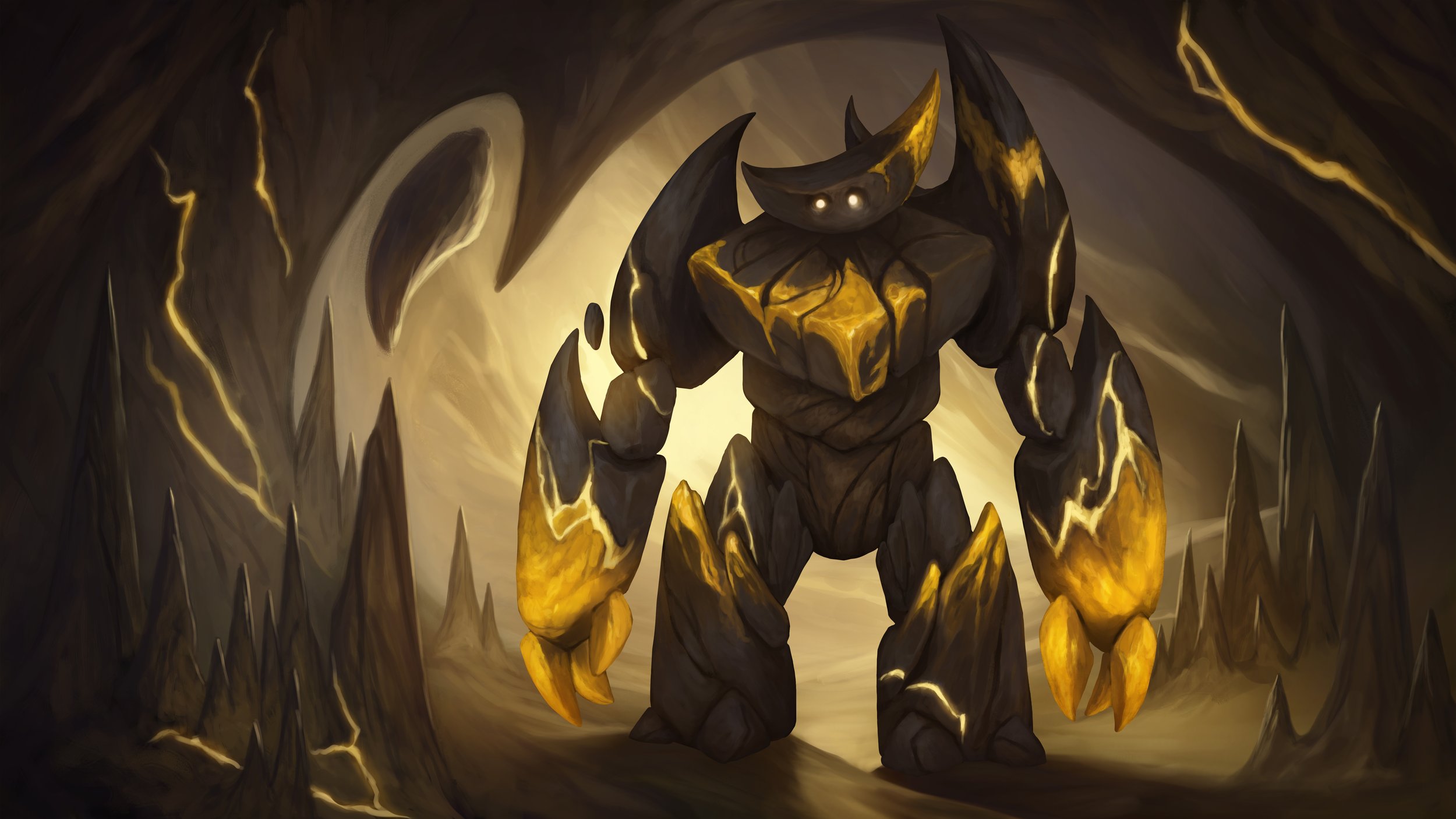
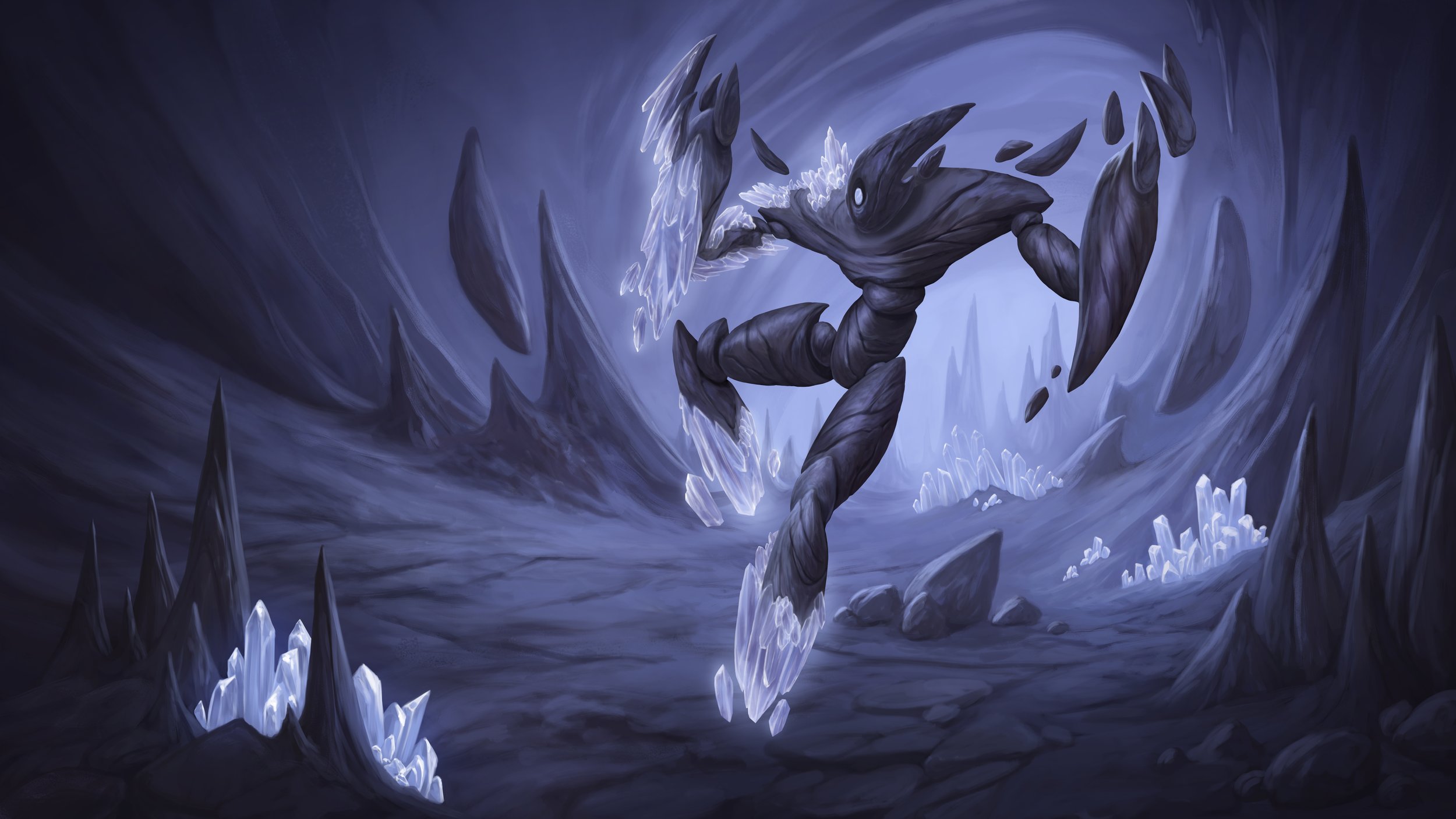
Check out more of Anthony’s work on Riftweaver’s new TTRPG, Fablecraft. Fablecraft is a cooperative digital tabletop roleplaying game set in the vibrant, hopeful world of Mythas. The platform integrates interactive battlemaps, video, audio, and text chat, digital dice and unique game system, and a library of artwork and music, to bring your stories to life.
























